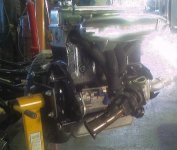Bremer
Jedi Hopeful
Offline
We know that 89 mm is the largest bore that pistons and liners are readily available for. I read about engines with 92, 92.5 and even 94 mm. I'm looking for some information on what would be involved in such modification.
I found that solid info on this is few and far between. I know the block has to be machined, but what features exactly? Can the bore centers still be on a straight line, or would they have to the offset?
How about cooling efficiency? Liners touching each other? Just a few of the issues that come to mind.
I totally realize that the most practical upgrade is the 89 mm bore kit. The benefits of a bigger bore may not be worth the amount of headache and cost to build the engine. Nevertheless, just wondering...
I found that solid info on this is few and far between. I know the block has to be machined, but what features exactly? Can the bore centers still be on a straight line, or would they have to the offset?
How about cooling efficiency? Liners touching each other? Just a few of the issues that come to mind.
I totally realize that the most practical upgrade is the 89 mm bore kit. The benefits of a bigger bore may not be worth the amount of headache and cost to build the engine. Nevertheless, just wondering...

 Hi Guest!
Hi Guest!

 smilie in place of the real @
smilie in place of the real @
 Pretty Please - add it to our Events forum(s) and add to the calendar! >>
Pretty Please - add it to our Events forum(s) and add to the calendar! >> 


